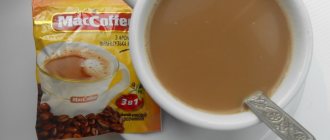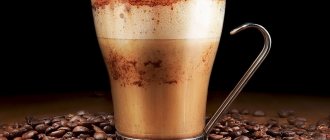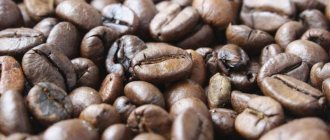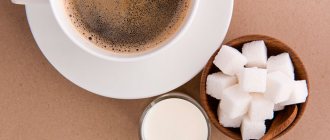A cup of coffee is a good “refuel” for the brain. Its contents contain many substances that help improve memory and speed up thinking. Coffee also helps you stay awake at night and improves your metabolism. Does it give the body energy? Low-calorie coffee significantly “adds” calories when milk, chocolate and other “taste improvers” are added to it. A simple calculation will help coffee gourmets avoid losing control over the amount of fats, proteins and carbohydrates they consume.
Coffee composition
Each variety of grains has a unique set of macro- and microelements, biologically active nutrients. Some components have not been thoroughly studied, but everyone knows that the main element that gives vigor and energy is caffeine.
What are the grains made of?
- proteins;
- fats;
- carbohydrates;
- caffeine;
- tannin;
- vitamins;
- minerals.
The main components of unroasted coffee beans are water, oils, and carbohydrates (mainly sugar and fiber). When roasting, the beans change their chemical composition: the amount of water decreases, the sugar caramelizes, due to which the grain acquires a dark brown hue. Fiber breaks down into alcohol and acids under the influence of temperature.
Composition of roasted beans:
- proteins;
- fats;
- carbohydrates;
- water;
- ash;
- alimentary fiber;
- vitamins;
- microelements.
The chemical composition of an instant drink differs from the natural product, since manufacturers often add dyes, stabilizers, flavors, and flavor enhancers. High-quality instant coffee, in addition to BJU, contains ash, water, dietary fiber, vitamins, iron, and phosphorus.
Chemical composition of coffee
There are two main types of alkaloids in beans: trigonelline and caffeine, which determine the final taste.
Chemical composition of coffee beans:
- Caffeine. The substance has an effect on the functioning of the nervous system and heart, has a diuretic property, gives energy, and eliminates drowsiness. The alkaloid is added to some medications: for migraines, to stimulate physical and mental activity, and to improve breathing during colds. In small doses, caffeine can eliminate drowsiness, but excessive consumption can have a negative impact on health.
- Theobromine. The substance is not in the shell, but in the center of the grain and does not invigorate, but, on the contrary, calms and even lulls. This is why instant drinks often make you sleepy, since they contain much more theobromine than caffeine.
- Tannin. In raw grains, the tannin content can reach up to 7.5%, but during roasting a significant part disintegrates. There is very little tannin in the brewed drink (about 1%), but it is this substance that gives the drink its unique aroma.
The following substances are also present in coffee beans:
- chlorogenic acids;
- theophylline;
- trigonelline.
Coffee beans contain a number of useful microelements: zinc, potassium, calcium, copper, B vitamins, PP and much more.
Nutritional value of coffee
The basis of any product is BZHU (proteins, fats, carbohydrates). Nutritional value of unsweetened coffee (per 100 g):
- proteins – 0.2 g;
- fats – 0.6 g;
- carbohydrates – 0.1 g.
Energy value of coffee
The calorie content of black coffee beans (per 100 g) is 223 kcal. There are 200 kilocalories per 100 grams of ground product.
Instant drink
The process of producing instant coffee involves introducing additives into the mixture, in addition to natural coffee. This product may contain both synthetic and natural oils. When choosing a drink that does not require brewing, you should definitely pay attention to its cost and composition.
The nutritional value of instant coffee is 118 kcal per 100 grams of product.
Calorie content of coffee and drinks made from it
There is a wide variety of drinks around the world that are prepared based on traditional espresso. Depending on the additional ingredients and volume, the calorie content of one serving in kcal can be as follows:
- unsweetened espresso – 1-2;
- unsweetened double espresso – 4;
- Americano – 2;
- in Turkish – 12;
- unsweetened cappuccino – 75;
- moccacino – 290;
- glasse – 125;
- Frappuccino – 400;
- raf – 84;
- instant coffee drink – 15-17;
- 3 in 1 – 60.
How many calories are in coffee without sugar?
This is the most dietary product with the lowest energy value. The calorie content of coffee without sugar is small - only a few kilocalories in one cup, but even a couple of spoons of sweetener can increase this figure many times over.
Calorie content of coffee with sugar
Black coffee has a sour taste if it is brewed from Arabica beans, and a bitter taste if Robusta beans are used. In the case when the ground mass combines both varieties, the taste is sourish-bitter. To improve the taste, a sweetener is usually added. But when adding sugar to a drink, you need to remember that every spoonful makes it more nutritious.
The nutritional and energy value of a sweet drink depends on how many spoons are added, what the final volume is, and what other ingredients are used. But you can calculate the indicator for a specific drink if you know how much sweetener will be added. A level teaspoon of sugar contains about 19 kcal, and a heaped teaspoon – 31 kcal, which means that 200 ml of drink contains approximately 57 kcal.
Many people use natural or artificial sweeteners instead of sugar. Natural sweeteners are sucrose, fructose, stevia, xylitol. Synthetic sweeteners, as a rule, do not contain calories, but natural ones, despite their fairly high nutritional value, are much healthier. The energy value of a cup of espresso with sweetener and medium-fat milk (70-80 ml) will be about 60-70 kcal, with fructose - about 100 kcal.
With the addition of milk, the taste becomes more delicate, but the calorie content of coffee also increases. All other milk components also work.
The calorie content of coffee with milk without sugar is about 58 kcal. Which is significantly higher than without a dairy ingredient, but lower than a drink with a sweetener. The calorie content of coffee with milk and sugar depends on the fat content of the milk used, as well as on how much sugar is added. For example, if you brew 200 ml of black coffee, add a couple of spoons of sugar and pour in 50 ml of milk (3.2%), you will get a drink with 90 kcal. The calorie content of coffee with cream is quite high, so it is better to use a dairy component with less fat content. One serving of black coffee with 50 ml of cream (at 10% fat) contains 100-110 kcal.
Calorie content of coffee drinks
Restaurants and coffee shops offer a large selection of coffee varieties, which are usually prepared using an espresso base with various ingredients. Each drink has its own nutritional and energy value. It all depends on the volume, the included components, and the method of preparation. For this reason, the calorie content of coffee drinks varies depending on the recipe and raw materials, even for the same type of coffee prepared in different places.
Calories in instant coffee
100 g of coffee powder/granules contains 90-100 kcal. It would seem that this is a rather large number if daily calorie counting is carried out. But to prepare a cup of an invigorating drink, you will need 1-2 tablespoons of dry matter, so the calorie content of a serving of instant coffee is small.
To make 200 ml of the finished product, several spoons of powder or granules are poured with boiling water. One small heaped teaspoon contains 6 kcal, but high-calorie additives (sugar, honey, cream, ice cream) increase the nutritional and energy value of the drink.
“3 in 1” coffee has gained popularity due to its pleasant taste and quick preparation. Unfortunately, the drink contains only 10-15% coffee, the rest is sugar, dry cream, flavorings and other chemical additives. One sachet (12.5 g) contains 50-60 kcal.
How do other ingredients affect the energy value?
True connoisseurs of the drink drink black espresso, but not everyone is a fan of the bitter and sour taste. Most people prefer to add sweetener and dairy.
What else can you use to make coffee:
- Condensed milk. A favorite ingredient that takes you back to childhood. Condensed milk will add a sweet milky taste, but the calorie content of coffee will increase significantly. 100 g of condensed milk contains 300 kcal, and one spoon – 36 kcal.
- Liqueurs. Sweet alcohol gives coffee an unusual taste, but also makes it higher in calories. Liqueurs are different, and the energy value may vary depending on what type is added to the drink. 100 ml of sweet alcohol contains at least 70-80 kcal.
- Syrups. The energy value of chocolate syrup is 149 kcal/100 g. A teaspoon of the sweet ingredient adds 37-40 kcal.
- Ice cream. To prepare homemade iced glass, first brew classic espresso, pour it into a cup, and put ice cream on top. With a 100 g scoop of ice cream, the calorie content of 100 ml of espresso will be 114 kcal.
How many calories are in 100 grams of coffee?
The calorie content of coffee without sugar depends on a number of factors. For example, the energy value of a natural and instant product differs significantly. Different metrics are recorded between the decaffeinated version and the flavored version.
Soluble
Instant coffee contains a minimum of fats, sugars and acids. These substances are simply washed away during the production process. The amount of natural raw materials in such a product does not exceed 15%. The rest of the composition is represented by all kinds of chemicals that give color and aroma. Therefore, the calorie content of instant coffee without sugar is higher than that of natural coffee.
Granulated coffee will have about 6 kcal per 100 grams of prepared drink. Lyophilisate – 12 kcal.
The calorie content of instant coffee without sugar is also affected by the brand of coffee. The table shows the energy value of products of different brands.
| Brand name | Calorie content per 100 grams | Kilocalories per teaspoon |
| Classic Nescafe | 56 | 5,6 |
| Black card | one hundred | 10 |
| Selfish | 90 | 9 |
| Jacobs Monarch | one hundred | 10 |
| Maxwell House | one hundred | 10 |
| Tchibo exclusive | 264 | 26,4 |
| Jardin | ninety two | 9.2 |
Black natural
Coffee beans contain fats, sugars and proteins. The fresher the roast, the higher its concentration. If beans are stored for a long time, these substances partially evaporate. The smallest amount is found in crushed grain stored in unsealed packages. As a result, if you chop freshly roasted fruits and cook them immediately, the number of calories in a cup of coffee will increase by 1-2 units.
It has been noted that nutritional value directly depends on the duration of extraction. For example, if the ground coffee beans were brewed Turkish, there will be only 4 kcal per 200 ml. The same batch cooked in a French press or filter will only contain one unit.
Calorie content of Arabica and Robusta
Different types of coffee beans have their own characteristics. Arabica and Robusta are most often found on the market; mixtures of them are often sold (60% Arabica + 40% Robusta).
| Arabica | Strong | |
| Thick | 15-17% | 10-11% |
| Acid | 5-8% | 7-10% |
| Sahara | 6-9% | 3-7% |
We see that Arabica has a little more fat and sugar, which will be included in the drink after preparation. And the longer the coffee is brewed, the more calories you will get. However, for a cup of coffee the difference will be 0.5 - 1 kcal, which is not that important for most people, even for those who carefully count calories. If you particularly like Arabica, there is no point in switching to Robusta just because it will cut your diet by 4-5 kcal per day.
Cafein free
This option is considered the lowest calorie, dietary option. However, not all so simple. The energy value of coffee largely depends on the technology used to remove caffeine. Typically, 1 cup of a drink made from natural ground grains contains 1 kcal. When using an instant product without milk and sugar, this figure will increase to 15.
With flavors
Flavorings contain sugar and fat. They have high energy value. The calorie content of one cup of aromatic coffee will double. When you drink a cherry, chocolate or hazelnut flavored drink prepared in Turkish style, your body immediately receives 8 calories.
Drink from a bag
The laziest preparation method is a 3-in-1 drink. The bag contains dry vegetable cream, instant coffee, sugar and various additives. One serving, which is recommended to be dissolved in 200 ml of water, contains about 70 kcal.
Calorie table for different coffee drinks
| Coffee, ml | Kcal per 100 grams | Kcal per serving |
| Express, 30 | 3 | one |
| Forbidden, 15 | 3 | 0,5 |
| American, 200 | 0,5 | one |
| Natural black, 200 | 2 | 4 |
| Natural with milk, 200 | 7-8 | 15 |
| Natural with milk and sugar, 200 | 15 | thirty |
| Black instant without sugar, 200 | 3-6 | 6–12 |
| Instant in milk without sugar, 200 | 10 | winds |
| Instant with milk and sugar, 200 | 25 | 50 |
| Coffee from a 3 in 1 bag, ml | 35 year | 70 |
Natural and not very sweet coffee with medium-fat milk will not harm your figure, but will provide a pleasant taste. In addition, in addition to the insignificant 20-30 kilocalories, it contains vitamins and microelements. But a drink from a bag contains a lot of “empty” calories, so it’s better not to drink this product often.
Calorie table for coffee and coffee drinks without sugar and other additives
| Drinking | Portion, ml | Calories per serving |
| Limited | 15 | one |
| Espresso | thirty | 2 |
| American | 180 | 2.2 |
| Double American | 240 | 4.4 |
| Drip coffee, filter, coffee (regular) | 220 | 2 |
| Kemex filter coffee | 240 | 3 |
| Air press coffee filter | 220 | 3.5 |
| French press coffee filter | 200 | 4 |
| Cold coffee | 240 | 6 |
| In Turkish, in Cezve | 200 | 4 |
| Soluble granular | 200 | 12 |
| Soluble lyophilized | 200 | 24 |
| Chicory | 240 | 46 |
| Green coffee | 220 | 0 |
| Decaffeinated coffee | 220 | 5 |
Summary table of coffee calories
Energy value of coffee drinks:
| Drink name | Calorie content in 100 grams (kcal) | Average serving (ml) |
| Americano | 21,05 | 250 |
| Espresso (double) | 9 | 95 |
| Glasse | 125 | 200 |
| Latte | 120 | 250 |
| Cappuccino | 105 | 350 |
| Mocaccino | 290 | 350 |
| Raf | 84,9 | 150 |
| Frappuccino | 300 | 450 |
Depending on the variety and type of coffee, preparation methods, quantity and fat content of ingredients, the data in the table may be different.
Proteins, fats and carbohydrates
Coffee is, first and foremost, beans. This means, like other legumes, they are rich in protein and fiber. And in addition, they contain many oils, natural fats of various types, including aromatic ones, which give it such a delicious aroma. Due to the large amount of oils, baristas have to clean the coffee machine so often. Over time, oils can go rancid and ruin the taste of the finished drink.
There is the concept of RDI - the norm of recommended daily intake of certain substances for a person.
To prepare a cup of espresso, 7 grams of ground beans are usually used, which produces:
| Grams | RSP | |
| Carbohydrates | 2,87 | 1% |
| Squirrels | 0,85 | 1,5% |
| Fats | 0,03 | 1% |
The total calorie content of a cup of coffee is 1-2 kcal, while the RDI is 2000 kcal. That’s why if you drink black without sugar, you don’t even have to consider it in your diet.
Recommendations for those who watch their figure
Those who count calories and control their own weight do not necessarily have to exclude the morning ritual in the form of a cup of invigorating espresso or Americano. It is enough to follow simple rules, and then your favorite drink will not interfere with weight loss:
- You can't drink coffee on an empty stomach. This negatively affects the functioning of the gastrointestinal tract and contributes to excess weight gain.
- Only natural coffee brings benefits. The soluble product contains chemicals that negatively affect the body.
- You should observe the measure and not abuse the quantity: 1-2 cups of espresso or Americano per day is quite enough.
- Green grains contain more antioxidants than roasted ones, which helps speed up your metabolism and help you shed extra pounds.
- For those watching their weight, it is advisable to drink natural espresso or Americano without sweeteners or calorie additives. You can also use ground cinnamon, ginger, lemon. You are allowed to pour in a little low-fat milk.
Most popular drink
According to statistics, people around the world drink more than two billion cups of coffee every day. This drink is most often drunk in New York. There consumption rates are seven times higher than in any other locality on the world map.
Coffee is number two after petroleum products in the purchase popularity ranking.
The number of coffee lovers around the world is growing every day. The aroma and unsurpassed taste of well-prepared coffee cannot leave anyone indifferent.
Vitamins and minerals
As we found out, the calorie content of coffee is extremely low. But this drink is considered healthy, as it contains important minerals and trace elements that our body needs. Of course, he gets them from other sources, but drinking coffee is usually healthier than not drinking coffee (if you do it in reasonable quantities).
Scientists believe that 2 cups of coffee a day is beneficial for all adults.
Here is a table of the main elements contained in a 100 ml cup of black coffee:
| Milligram | RSP | Benefit | |
| Calcium | 5 | 1% | Strengthens bones, teeth, nails |
| Magnesium | 7 | 2% | Important for heart function |
| Phosphorus | 7 | 1% | For the formation of bones, teeth and nerve cells |
| Potassium | 116 | 3% | Good for muscles |
| Zinc | 0,5 | For healthy skin and hair | |
| Manganese | 0,1 | 3% | For cell development and iron absorption |
| B5, pantothenic acid | 0,6 | 6% | Anti-stress vitamin |
| B2, riboflavin | 0,2 | 11% | For health and beauty |
| B3, niacin | 0,5 | 2% | Particularly beneficial for the skin |
The type of water used in preparation (hard or soft) can affect the micronutrient content of a cup of black coffee, especially in relation to calcium and magnesium levels.
Antioxidants
By and large, antioxidants are important for us to improve our overall well-being and the body’s ability to absorb and properly use beneficial substances. Coffee is rich in antioxidants, and the lighter the roast, the more of them, which is why green beans are considered so beneficial.
Depending on the degree of roasting, one cup can contain from 80 to 320 mg of an important antioxidant - chlorogenic acid.
Chlorogenic acids help improve metabolism, establish intercellular metabolism, and also promote weight loss. Researchers say coffee contains 500 times more antioxidants than vitamin C.
Nutritional value of popular types of coffee
We've looked at black coffee, but not all of us drink it that way. Women who watch their weight often think about caloric intake, and they just like drinks with at least milk, and even sugar or sweeteners.
Here is a table of the nutritional value of coffee:
| Volume | Kcal | Fats | Squirrels | Carbohydrates | |
| Coffee with skim milk | 240 | 8 | 0,2 | 0,4 | 1,3 |
| Coffee with sugar | 240 | 38 | 0,2 | 0,2 | 9,5 |
| McDonald's, small Cappuccino | 200 | 59 | 3 | 3 | 5 |
| McDonald's, average Cappuccino | 300 | 86 | 4 | 5 | 8 |
| McDonald's, small Latte | 200 | 75 | 4 | 4 | 7 |
| McDonald's, medium latte | 300 | 118 | 6 | 6 | 10 |
| chocolate maker, latte | 400 | 219 | 8,7 | 8 | 26,7 |
| Chocolate girl, Raf | 400 | 345 | 23,6 | 6,7 | 25,3 |
| Chocolate girl, Cappuccino light | 320 | 84 | 1,5 | 6,3 | 10,8 |
| Chocolate girl, Cappuccino | 320 | 144 | 8 | 7 | 11 |
| CoffeeHouse, Mocha | 220 | 131 | 5,8 | 4,7 | 15,2 |
| CoffeeHouse, Latte | 220 | 89 | 4,8 | 4,5 | 7 |
| CoffeeHouse, Cappuccino | 350 | 121 | 5,5 | 6,2 | 10,6 |
| 3 in 1 Nescafe | bag | 67 | 2 | 0,2 | 12 |
The calorie content of the drink increases noticeably if milk is added to it. The coffee cocktails you get in cafes contain quite a lot of milk, and the larger the drink, the more calories (protein, fat and carbohydrates) you get.
When you pour some milk into your cup at home, the amount is rarely more than 50ml and has fewer calories.
If you control calories and strive to consume less, it is better to order an Americano with milk at a cafe, rather than a cappuccino, or, especially, a latte.











